Methylisothiazolinone is a synthetic preservative with a broad spectrum of action against bacterial flora and a weaker antifungal effect.
The addition of the component to the composition of cosmetics helps to significantly increase the shelf life. At the same time, methylisothiazolinone cannot be called 100% hypoallergenic. In addition, the compound can be neurotoxic and environmentally hazardous.
What is Methylisothiazolinone
Methylisothiazolinone (MIT) is a member of the isothiazolinone group, a modern preservation additive. Isothiazolinones were positioned as an alternative to toxic formaldehydes and parabens controversial in terms of safety.
The compound is a colorless liquid with a weak odor, readily soluble in water, compatible with:
- different types of surfactants (surfactants);
- proteins - the basic components of any emulsion;
- emulsifiers.
A feature of all members of the isothiazolinone family is the ability maintain its biocidal effect (destroy harmful microflora) when:
- temperature changes (including when heated to 60 degrees Celsius);
- change in acidity (pH values from 2 to 9).
Methylisothiazolinone has a related compound, methylchloroisothiazolinone (CMIT). CMIT is a halogenated preservative (chemical formula includes chlorine). Often they are used in combination - you can see MIT / CMIT in the composition.
Also, the presence of MIT / CMIT in cosmetics can be indicated by:
- Kathon CG;
- Kordek;
- MCI / MCIT;
- Microcare MT;
- Neolone PE;
- Optiphen MIT;
- Rokonsal KS 4;
The action of methylisothiazolinone in cosmetics
Methylisothiazolinone is used in water-based cosmetics to warn:
- mold growth;
- the appearance of an unpleasant odor;
- the formation of toxins as a result of the active vital activity of microbes.
Any water-based cosmetics, regardless of the form of packaging, needs conservation.
Otherwise, it significantly decreases:
- shelf life - even if the package is closed (some bacteria can multiply in the absence of air);
- period of use after opening (indicated on the packaging by the icon "jar with an open lid") - air access significantly "enriches" the composition of harmful microflora.
Methylisothiazolinone (often referred to as MIT in cosmetics) provides a combination of three effects:
- bactericidal (fight against bacteria);
- fungicidal (preventing the vital activity of fungal cells);
- algicidal (destruction of varieties of mold microalgae).
The MIT molecule has a pronounced toxic activity that prevents cellular respiration of microorganism cells. Since the substance is definitely not safe at a concentration of 5%, the recommended percentage of input into cosmetics is from 0.1 to 2.5%. For a number of brands, the actual figures can be much lower - from 0.002 to 0.004%.
What cosmetics contain
According to the current recommendations of the European Association of Cosmetologists, methylisothiazolinone should be used only in rinsed products.
Accordingly, an ingredient “legally” may be included in:
- milk / tonic for washing;
- toothpastes;
- mouth rinses;
- liquid soaps, gels and shower foams;
- scrubs and peels;
- intimate hygiene products;
- shampoos and hair balms;
- means for removing nail polish.
However, in reality, you can see MIT as part of indelible products:
- serums and creams;
- lotions and body milk;
- impregnation of wet wipes;
- sunscreens;
- children's cosmetics.
At the same time, the component is actively exploited by brands of the mass market level (low price segment), among them:
- Yves Rocher;
- Nivea;
- Procter and Gamble.
Methylisothiazolinone is present in the intermediate price category (L'Occitane).
An expensive preservative (MIT is more expensive than parabens) is also in demand among luxury cosmetics manufacturers:
- Giorgio Armani;
- Helena Rubinstein;
- Clarins;
- Sensai.
Among the Russian brands whose owners use MIT in production:
- Black Pearl;
- 100 beauty recipes;
- Neva cosmetics.
The component often appears in the composition of products positioned as "paraben-free", "ECO" / "BIO" of Russian or foreign production. At the same time, the loud statements of the manufacturer are not confirmed by the presence of eco-certificates.
The safety of using methylisothiazolinone
Theoretically, the use of any preservatives allowed in cosmetology is justified: the probable harm from a chemical compound is much less than the threat associated with the use of cosmetics contaminated with microflora. Methylisothiazolinone has been used in cosmetics since the 1970s.
At the time of component certification, studies confirmed that the substance:
- has no teratogenic / mutagenic effect (does not cause disturbances or mutations during fetal development);
- is not a formaldehyde donor - does not decompose in cosmetics with the release of this toxic substance;
- well soluble in water - migration to the fat phase with a deterioration in the quality of conservation is excluded;
- compatible with formulation components;
- does not accumulate and does not pollute the environment (biodegradable).
The introduction of the component into the composition in concentrations up to 2.5% is allowed in the USA, application in the territory of the European Union and the Russian Federation is regulated accordingly:
- EC 1223/2009;
- TR CU 009/2011.
In Japan, it is forbidden to use a preservative in leave-in products, and in Germany, it is not allowed in children's cosmetics. Since 2002, several studies of the safety of the component have been carried out, the individual conclusions on which are presented in the table.
| Year, country | Theme | Conclusions, remarks |
| 2002, USA, Brown University | Effect of low and slightly increased concentrations on tadpoles | A slight increase in concentration leads to a delay in the development of the nervous system It should be understood that invertebrates do not have a protective skin barrier |
| 2002, USA, University of Pittsburgh | Effect of low concentrations on mature nerve cells | Exposure of samples of mature neurons in a solution of low concentration (0.0004-0.0012%) caused the death of nerve cells At the same time, safety in cosmetics was emphasized. |
| 2005, Japan | Assessment of the toxic effect of biocides, when released into wastewater, and then into sea water. | The compound is toxic to fish and marine invertebrates. |
There is information that the substance is able to accumulate in the body and damage mature nerve cells in mammals. Numerous cases of exacerbation of allergic dermatitis after the use of the drug suggest the immunotoxicity of the compound - the ability to damage the cells responsible for the body's immune responses.
In addition, there are a number of facts / recommendations, based on research and statistics, among them (in chronological order):
- British physicians' appeal to cosmetics manufacturers to remove methylisothiazolinone and methylchloroisothiazolinone from products (2013).
- Methylisothiazolinone recognized as Allergen of the Year by the American Dermatitis Society (2013).
- Recommendations to abandon the use of the component in indelible cosmetics, in particular wet wipes - from the trade group "Cosmetics Europe" and "European Society of Contact Dermatitis" (2013).
- Voluntary ban on the use of an ingredient in body creams from the European Commission Consumer Safety Committee. According to the commission, the rapid increase in contact reactions to isothiazolinones is associated with an increase in products containing these components. The presence and cause of allergies were confirmed by the results of application skin tests (2014).
- Ban on adding to indelible cosmetics in the European Union (2015).
Methylisothiazolinone appeared in cosmetics almost half a century ago. Until 2013, there was an increase in the number of allergy cases, but at present (possibly due to the introduction of restrictions) contact reactions are less common.
Effects
Methylisothiazolinone in cosmetics (subject to the concentration and rinsing of the product) is safe for people whose skin is not hypersensitive. However, the substance has a high sensitization index of 9.
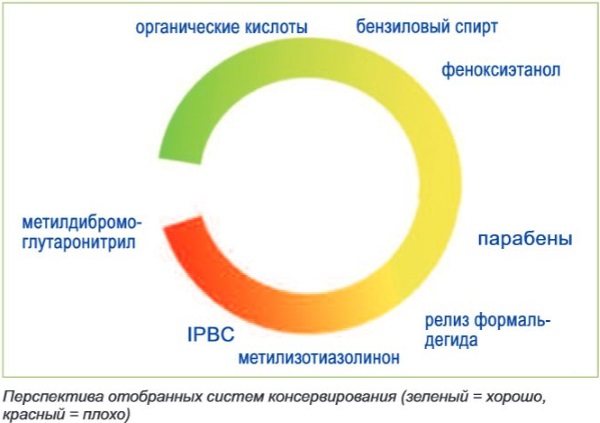
For consumers who are prone to allergies or contact dermatitis, the use of cosmetics can provoke:
- itching;
- burning;
- small rash;
- skin damage up to burn-like ulceration - in rare cases;
- reactions of photostress contact dermatitis - exacerbation of skin manifestations after exposure to the sun.
The reaction can occur both immediately and after a while - within several months of regular use of the cosmetic product.
Recommendations for choosing cosmetics
According to experts, in the near future it is unlikely that a complete ban on the use of a preservative will be discussed - it is more likely that the permissible concentrations will be adjusted. Also, manufacturers are actively looking for optimal combinations of preservatives that can increase the effectiveness of the preservation system and reduce toxicity.
In the meantime, you can give consumers the following recommendations:
- refuse to buy cosmetics for children / leave-in products containing methylisothiazolinone;
- when purchasing imported funds, pay attention to the actual place of production (on the territory of the European Union, the USA, or the Russian Federation);
- if you have a tendency to dermatitis or photosensitization, give preference to cosmetics with "green" preservatives that have certificates (Ecocert, Russian and European eco-certificates);
- avoid contact of products with methylisothiazolinone with the area around the eyes or mucous membranes of the eyes.
The presence of methylisothiazolinone in professional products of the luxury segment should raise fewer questions (in comparison with budget "light" products).
This is due to two nuances:
- such cosmetics contain more active ingredients. And the more “powerful” the agent as a whole, the more effective the conservation system should be;
- reputable brands protect their reputation and carefully control the content of preservatives, choosing low concentrations and / or safe combinations.
Alternative options
According to experts, there is no reason to expect new preservatives to appear on the market. When choosing cosmetics, it should be understood that all preservatives have advantages, disadvantages and nuances of use.
Brief information is given in the table:
| Preservative type | pros | Minuses | Features: |
| Aldehydes and their donors | Cosmetic formaldehyde is chemically identical to formaldehyde, which is naturally found in the body of humans and plants |
| Unscrupulous manufacturers often indicate methylene glycol instead of formaldehyde - although in fact they are the same thing. |
| Parabens (methyl- and propylparaben) |
|
| There was no talk of a direct connection between cosmetics and breast cancer, and hormonal activity is several times less than dietary phytoestrogens (soy). However, the minimum permissible concentration of the substance continues to be reduced. |
| Alcohols (ethyl, isopropyl, benzyl) |
|
| Active cosmetics are rarely alcohol-free, but for dry skin it is better to purchase light creams, lotions and tonics without alcohol. |
| Acids (benzoic, salicylic) |
|
| Such preservatives are appropriate in cosmetics for daily use. |
| Isothiazolinones |
|
| The use of isothiazolinones in active rinse off cosmetics is justified. |
| Halogenated compounds |
|
| The most "undesirable" from the point of view of security is considered to be bronopol. |
| Compounds that are not officially preservatives, but have antimicrobial activity |
|
| Cosmetics with such additives are often labeled "preservative-free". |
The addition of "green" preservatives (no aldehydes, halogens and parabens) requires the manufacturer to:
- perfect production hygiene;
- high concentrations of preservative ingredients;
- the use of premium quality active ingredients;
- special water treatment.
All these factors significantly increase the cost of cosmetics - therefore, you should be wary of budget funds with the declared "green" composition.
Methylisothiazolinone is a modern preservative that successfully prolongs the shelf life of cosmetics. The substance is safe when used in rinse-off products and when concentrations are observed. However, for people suffering from hypersensitivity or a tendency to dermatitis, it is better to refuse products with methylisothiazolinone, preferring "green" preservatives.
Interesting videos about methylisothiazolinone, its properties and uses
Preservatives in cosmetics:
Compositions of cosmetics:

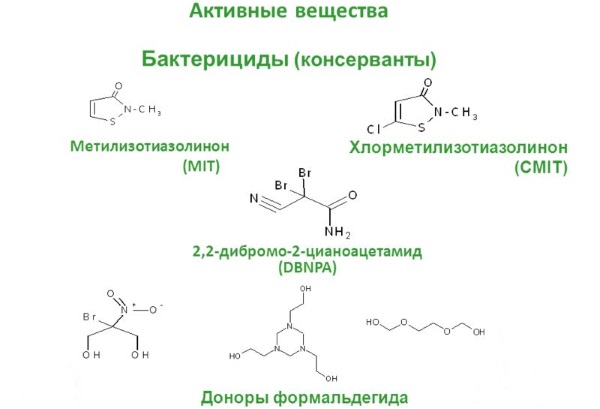
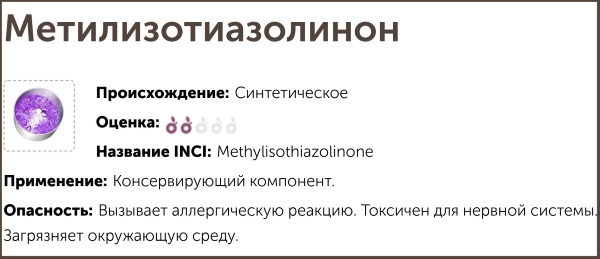
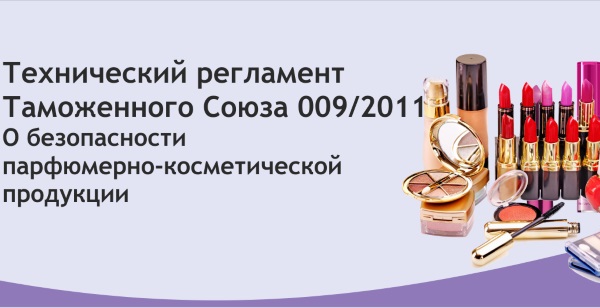

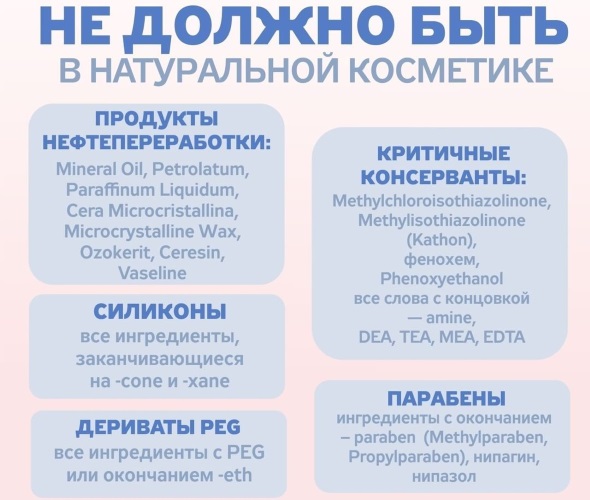
I rarely look at the composition of cosmetics, I mainly rely on reviews and advertising promises. But now I will study the labels more carefully !!